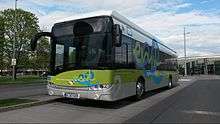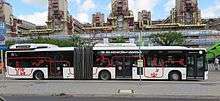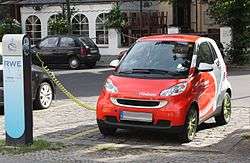Battery electric bus
A battery electric bus is an electric bus that is driven by an electric motor and obtains energy from on-board batteries. Many trolleybuses use batteries as an auxiliary or emergency power source.

History

The London Electrobus Company started running the first ever service of battery-electric buses between London's Victoria Station and Liverpool Street on 15 July 1907.
The first battery buses were mostly small, mini- or midi- buses. The improvement of battery technology from around 2010 led to the emergence of the battery bus, including heavier units such as 12.2-meter (40 ft) standard buses and articulated buses. China was the first country to introduce modern battery electric buses in large scale. In 2009 Shanghai catenary bus lines began switching to battery buses.[1] In September 2010, Chinese automobile company BYD began manufacturing the BYD K9, one of the most popular electric bus.
The first city to heavily invest in electric buses was Shenzhen, China. The city began rolling out electric buses made by BYD in 2011, with the objective of having a fully electric fleet. By 2017, Shenzhen's entire fleet of over 16,300 buses was replaced with electric buses, the largest fleet of electric buses of any city in the world.[2]
According to Bloomberg, "China had about 99 percent of the 385,000 electric buses on the roads worldwide in 2017, accounting for 17 percent of the country’s entire fleet." Chinese cities are adding 1900 electric buses per week.[3]
Other events
- In 2011, bus manufacturer Contrac Cobus Industries from Wiesbaden announced the Cobus 2500e.
- In autumn 2012, Czech manufacturer Inmod supplied a 8-meter-long (26 ft) vehicle has 22 seats, 35 standing places and a range of 160–170 kilometers (99–106 mi) a day, up to 220–260 km (140–160 mi) can be extended. The bus is recharged with a quick charger twice a day for one hour. Its maximum speed is 80 km/h (50 mph).[4]
- Beginning in 2012, the Wiener Linien on bus routes 2A and 3A use electric buses. They are charged to the end user via a pantograph, which is applied to short catenary pieces. These are fed by the tram catenary. The cars have a range of around 150 kilometers (93 mi).[5]
- In May 2013, a battery bus began running between the airport and Palexpo in Geneva, Switzerland. This bus can be partially charged within 15 seconds. At the end of the line the charging process takes three to four minutes. The project cost five million francs.[6]
- The Regional Transport Ruhr-Lippe GmbH (RLG) (Germany) began operating an electric minibus as a Quartierbus in May 2013. Vehicle range is approximately 120 kilometers (75 mi). Recharging takes about three hours when fully discharged. Recharging consumes over 1.5 hours during the lunch break.[7]
- In 2013 battery buses entered service in the Netherlands.[8]
- In Germany in 2013 battery buses were undergoing tests in Bremen and in Bonn.[8]
- The largest battery bus fleet is in Dalian, China. It includes 600 BYD buses. The purchase of a further 600 vehicles was planned for 2015.
- In 2015 BYD planned to launch the first battery-double-decker bus.[9]
- In Braunschweig battery buses entered regular service at the end of 2013. The "Emil" (Electromobility means of inductive load) project uses inductive charging.[10][11] Both vehicles and charging stations were developed with Bombardier.[12]
- In Gumi, South Korea in 2013 a road section was modified to allow inductive charging while driving. The technology was to be tested with two electric buses.[13]
- In California, battery school buses since the end of October 2013 because of significantly lower operating costs, are used.[14]
- In Hamburg Rampini battery buses entered service in 2014 on line 48.[15][16]
- Dresdner Verkehrsbetriebe together with the Fraunhofer Institute for Transportation and Infrastructure Systems began testing battery buses on November 3, 2014.[17] On June 17, 2015 passenger service began on the first route in Saxony. A four-minute stop at the last stop provides sufficient charge, with a high-power charger to preheat the passenger compartment.[18]
- The Munich public transport company began testing battery buses in 2008. Experiments with Ebusco vehicles of were expected to reach a range of 300 km (190 mi) using lithium iron phosphate batteries.[19]
- In Pinneberg testing began in 2014.[20]
- In September 2015 four battery buses entered service in Berlin. The Solaris Urbino 12 charge by induction at the last stop.[21][22]
- In July 2015 the Schleswig-Holstein Rendsburg purchased a Sileo battery bus with a range of 200 km (120 mi) for 450,000 euros. The bus does not charge during operation and can be operated for half a day. The bus is charged from a rooftop photovoltaic system.[23]
- In Bonn test entered regular service in 2013. The range is at least 200 km (120 mi).[24]
- Botosani, Romania planned for public transport to operate fully electrically. at a conversion cost of 20 million euros.[25]
.jpg)
- In October 2015 the double-decker buses were converted to BYD electrics with a range of 250 km (160 mi). London's center-city access toll is waived for battery buses.[26][27]
- In 2015, BYD aimed to sell 6,000 of its buses worldwide.[28] BYD is the world leader in the sale of electric vehicles.[29]
- The California Department of Transportation contracted with Antelope Valley Transit Authority (AVTA) to switch its buses to 85 BYD battery buses with a range of at least 160 miles (260 km). Models include a 40-foot (12.19 m) low-floor transit bus, a 60-foot (18.29 m) low-floor articulated and a 45-foot (13.72 m) commuter bus. Savings were expected to be $46,000 (41,300 euros) per bus per year.[30][31]
Charging
Scheduling
Charging electric bus batteries is not as simple as refueling a diesel engine. Special attention, monitoring, and scheduling are required to make optimal use of the charging process, while also ensuring proper battery maintenance and safekeeping. Some operators manage these challenges by purchasing extra buses. This way the charging can take place only at night. It is a safe solution, but also very costly and not scalable. Another solution is ensuring that the vehicle daily schedule takes into account also the need to charge, keeping the overall schedule as close to optimal as possible. Today, there are various software companies that help bus operators manage their electric bus charging schedule. These solutions ensure that buses continue to operate safely, without any unplanned stops and inconvenience to passengers.
Supercapacitors can be charged rapidly, reducing the time needed to prepare to resume operation.[32]
Communication standards
For communication between charger and electric bus the same ISO 15118 protocol is used as for passenger car charging. The only differences are in the charging power, voltage and coupler.
Pantographs and underbody collectors
Pantographs and underbody collectors can be integrated in bus stops to quicken electric bus recharge, making it possible to use a smaller battery on the bus, which reduces the initial investment and subsequent costs.[33][34][35][36][37]
Advantages
Battery electric buses offer zero-emission, quiet operation and better acceleration compared to traditional buses. They also eliminate infrastructure needed for a constant grid connection and allow routes to be modified without infrastructure changes compared to a Trolleybus. They typically recover braking energy to increase efficiency by a regenerative brake. With energy consumption of about 1.2 kW⋅h/km (4.3 MJ/km; 1.9 kW⋅h/mi), the cost of ownership is lower than diesel buses.[38][39]
Disadvantages
As of 2016 battery buses have less range, higher weight, higher procurement costs. The reduced infrastructure for overhead lines is partially offset by the costs of the infrastructure to recharge the batteries. Battery buses are used almost exclusively in urban areas rather than for long-haul transport. Urban transit features relatively short intervals between charging opportunities. Sufficient recharging can take place within 4 to 5 minutes (250 to 450 kW [340 to 600 hp]) usually by induction or catenary.[38]
Although the initial purchase cost of the vehicle is higher than conventional and hybrid buses, Proterra, Inc. asserts the total cost of ownership over a twelve-year lifecycle is lower thanks to reduced maintenance and energy/fuel costs.[40]
See also
| Wikimedia Commons has media related to Battery-powered buses. |
References
- Shanghai: Investitionen im Netz bleiben aus, Meldung auf www.trolleymotion.ch vom 12. November 2012
- "All Shenzhen public buses now electric 全球规模最大!深圳专营公交车辆实现纯电动化"
- Bloomberg - Are you a robot?
- Der SOR-Elektrobus auf www.inmod.de Archived February 28, 2015, at the Wayback Machine
- Elektrobusse ab 2013 in der City. auf wien.orf.at, retrieved, 10 September 2012.
- DOSSIER DE PRESSE AVRIL 2013, TOSA Archived 2015-08-29 at the Wayback Machine (PDF; 543 kB)
- GmbH, Regionalverkehr Ruhr-Lippe. "Seite nicht gefunden". Archived from the original on 2016-03-14.
- newstixs, 30. Juni 2013: Elektromobilität für Bonn: Positive Testergebnisse mit chinesischem Elektrobus, aufgerufen 16. Juli 2013
- BYD Internetauftritt des Herstellers. Retrieved, 23 November 2014.
- Braunschweiger Verkehrs AG: Elektrobusse mit induktiver Ladetechnik – der Schritt in ein neues Zeitalter Archived August 20, 2014, at the Wayback Machine, aufgerufen 8. Oktober 2013
- YouTube: EmiL - Elektromobilität mittels induktiver Ladung, Videoanimation, aufgerufen 8. Oktober 2013
- eurailpress.de, 11. September 2013: Bombardier: Primove-Station in Braunschweig in Betrieb, aufgerufen 8. Oktober 2013
- Bild.de, 8. August 2013: Südkorea setzt Straßen unter Strom, aufgerufen 21. Oktober 2013
- EarthTechling, 4. November 2013: Electric School Bus Idea Set To Debut In California, aufgerufen 16. November 2013
- Münder, Peter (28 October 2014). "Elektromobilität: Die Bergziege summt jetzt" – via Die Zeit.
- "Aktuell – SAT.1 REGIONAL". Archived from the original on 2015-09-24. Retrieved 2015-07-10.
- Fraunhofer-Elektrobus wird auf Linie 61 getestet
- "OmnibusRevue - Erste E-Buslinie Sachsens nimmt Betrieb auf".
- muenchen.de. "SWM und MVG testen neuen Elektrobus".
- Neuer batteriebetriebener E-Bus fährt in Pinneberg Archived 2015-07-05 at the Wayback Machine, 12. Mai 2014
- Die BVG präsentiert ihre neuen Elektrobusse, 1. Juli 2015
- Video: Elektrische Buslinie in Berlin startet in die Testphase, 8. Juli 2015
- Umweltfreundlich, leise, aber noch nicht ausgereift, 7. Juli 2015
- Stadtwerke kaufen sechs Elektrobusse, 7. Juli 2015
- Elektromobilität in Rumänien: Gemeinde plant 100% elektrischen ÖPNV, 23. Juni 2015
- London kauft elektrische Busse aus China, 10. Juli 2015
- Londons Doppeldecker fahren bald elektrisch, 10. Juli 2015
- BYD anticipated sales of 6,000 electric buses worldwide in 2015 vom 6. Januar 2016. Retrieved, 6 January 2016.
- China’s BYD is World’s Largest EV Manufacturer vom 28. Dezember 2015. Retrieved, 6 January 2016.
- it-times.de, 12. Februar 2016: BYD: Großauftrag für Elektrobusse aus Kalifornien, aufgerufen 8. März 2016
- oekonews.at, 17. Februar 2016: Kalifornien: Die erste 100% elektrische Busflotte rollt demnächst, aufgerufen 8. März 2016
- MIT-Technology Review: Next Stop: Ultracapacitor Buses, aufgerufen 18. November 2013
- Large-capacity, flash-charging, battery-powered pilot bus takes to the street.
- "Current collectors for electric busses". www.schunk-sbi.com. Schunk Carbon Technology. Archived from the original on 2017-01-21. Retrieved 2019-09-18.
- "A Giant Charger That Juices Up Electric Buses in Three Minutes".
- Ultrafast Electric Bus Charging, Opbrid
- Trolley:Motion, 27. Mai 2013: Shanghai - Weitere Reduzierung des Trolleybusnetzes - ungewisse Zukunft Archived December 3, 2013, at the Wayback Machine, aufgerufen 8. Oktober 2013
- Fraunhofer-Institut für Verkehrs- und Infrastruktursysteme Praxistest mit einem Fahrzeug zwischen 03.11.2014 bis zum 30.01.2015
- BYD erhält Rekordbestellung über 2000 eBusse und 1000 Elektroautos Archived 2016-01-06 at the Wayback Machine V. 12. May 2014. Retrieved, 15 July 2015.
- "Proterra Catalyst Platform Introduction" (PDF). Louisiana Alternative Fuels Conference & Expo. April 14, 2016. Retrieved July 13, 2018.

_Arriva_London_New_Routemaster_(19522859218).jpg)